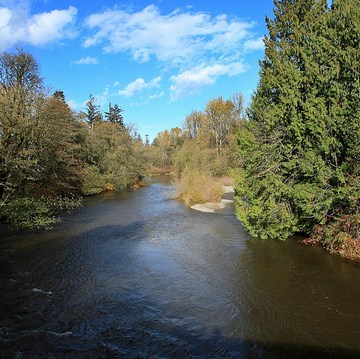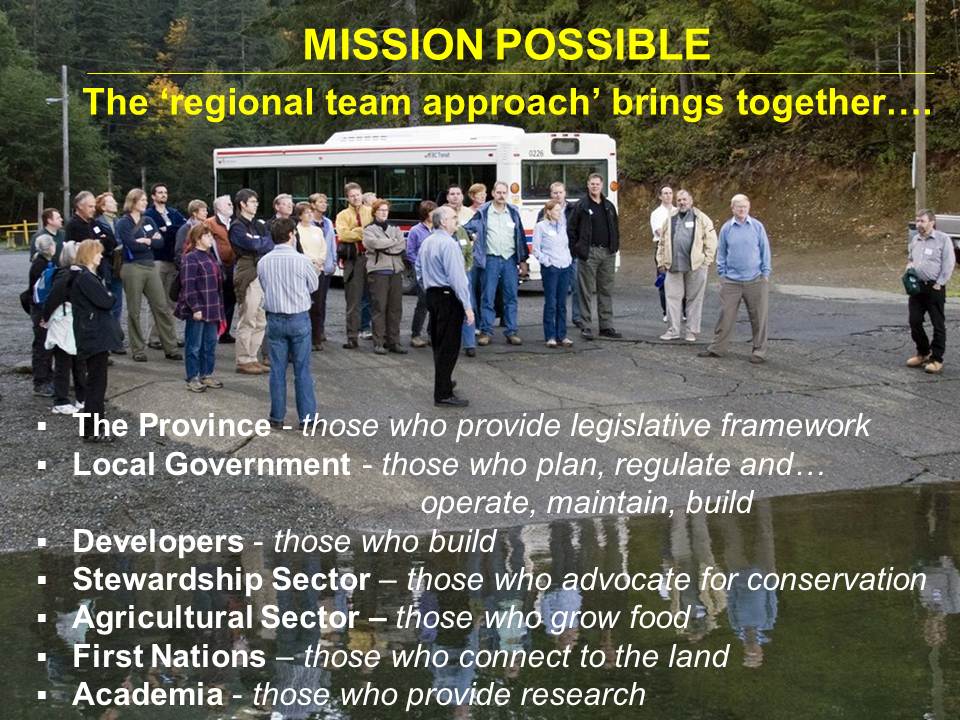“Tsolum River restoration story is all about sharing a vision and mutual respect,” observes CAVI’s Eric Bonham

Restoration of Tsolum River
After a small open-pit copper mine on Mount Washington on Vancouver Island closed in the 1960s, leaching copper eliminated fisheries in the Tsolum River watershed. Remediation work in the ’80s and ’90s improved water quality but wasn’t enough to support a healthy fisheries resource.
In 2001, a partnership developed to restore the fishery became the Tsolum River Partnership. By 2009, copper contamination from the site had decreased by 77 per cent, drastically improving water quality and initiating the recovery of fisheries resources. In the fall of 2009, there were more pink salmon in the river than had been seen in 50 years.
The Goal: A Self-Sustaining System
 “The exciting thing about this is that now we can go to work and repair the ecosystems. We can actually restore fish habitat and riparian areas, build refuge habitat, stabilize banks, stabilize sub-straits, and end up with a system that’s going to be self-sustaining. It will probably take us another 20 years to do that. But at least we can do that now…It’s really, really exciting,” stated Jack Minard, Executive Director of the Tsolum River Restoration Society.
“The exciting thing about this is that now we can go to work and repair the ecosystems. We can actually restore fish habitat and riparian areas, build refuge habitat, stabilize banks, stabilize sub-straits, and end up with a system that’s going to be self-sustaining. It will probably take us another 20 years to do that. But at least we can do that now…It’s really, really exciting,” stated Jack Minard, Executive Director of the Tsolum River Restoration Society.
“There is a caveat to the ‘good news’. That caveat is that there is no trend showing yet, there are many other problems in the Tsolum that require much human intervention to solve. And even though we have had some great runs since water quality has been dramatically improved and continues to improve, we are not yet out of the woods. Loose substrates, extreme flows (too high and rapid flows moving substrates and killing spawned eggs and too low flows leaving coho and trout high and dry in the late summer) and temperature problems among others still plague the river.”
“We have been busy working on the minesite and now that water quality is under control, we can go to work on a recovery plan that tackles the myriad of problems and issues that remain. We have had some good runs BUT we need to see consistency and a self-sustaining ecosystem before we can celebrate again. For now though, we are celebrating our incredible accomplishment of improved water quality!”
Premier’s Award for Innovation and Excellence
 In recognition of their commitment and accomplishment, the Tsolum River Partnership has been honoured with a 2011 Premier’s Award for Execellence and Innovation.
In recognition of their commitment and accomplishment, the Tsolum River Partnership has been honoured with a 2011 Premier’s Award for Execellence and Innovation.
The Premier’s Awards acknowledge outstanding achievements in public service. “I would like to thank each of these recipients for their leadership, dedication and incredible determination,” Premier Christy Clark said in a news release.
To Learn More:
“On April 28th, 2009 as I sat in a Tsolum River Partnership meeting at the Ministry of Environment offices in Nanaimo on Vancouver Island, I let my mind wander back to the beginnings of how we got here,” reflected Jack Minard in an article published by the Watershed Sentinel in June/July 2009. To read the complete story, click on Creating Partnerships to Save the Tsolum River from Copper Leachate
To view a 2-minute video about the Premier’s Award that is posted on YouTube, click on Tsolum River Partnership Reduces Copper Contamination and Brings Salmon Back
Collaboration and a Common Vision
“The Tsolum River story strikes a very personal chord for me from my days in the early 90’s when I was Manager of the Urban Salmon Habitat Program (USHP) with the Fisheries Branch in the Ministry of Environment,” reflects  Eric Bonham, a founding member of Convening for Action on Vancouver Island, known by the acronym CAVI. He was formerly a Director in both the Ministry of Environment and the Ministry of Municipal Affairs.
Eric Bonham, a founding member of Convening for Action on Vancouver Island, known by the acronym CAVI. He was formerly a Director in both the Ministry of Environment and the Ministry of Municipal Affairs.
“The USHP was all about community stewards working with local government and the private sector. I was aware of the Tsolum River issue then and knew about it through Murray Galbraith a colleague with the Ministry of Mines at the time. I also note that Father Charles Brandt was a central figure in the Tsolum River story…a true champion if ever there was one whose wisdom was respected by all who knew him.”
Partnerships and Mutual Respect
“The Tsolum story underscores the value of community stewards working collaboratively with government agencies and the private sector towards a common vision. It also highlights the need for dedicated insiders within government who “stay the course” and remain committed… for it’s all about partnerships and mutual respect.”
“What has this to do with CAVI..well a significant amount I believe…for I see the identical qualities with the teamwork and leadership demonstrated within the Comox Valley-CAVI initiatives.”
Shared Responsibility
“What is interesting about the Tsolum River recovery story is not only the participation by the various agencies, but also the acceptance of responsibility of the range of partners that recognized the long term impacts of poor logging and mining practices and then demonstrated the collective fortitude to address the situation. No doubt Jack Minard and the Tsolum River Restoration Society played a significant role in this regard..!”
Ethics, Economics and the Environment
 “The Tsolum story brings to mind the wisdom of Aldo Leopold regarding issues relating to ethics, economics and the environment. In his diary, A Sand County Almanac, he noted:
“The Tsolum story brings to mind the wisdom of Aldo Leopold regarding issues relating to ethics, economics and the environment. In his diary, A Sand County Almanac, he noted:
“Examine each question in terms of what is ethically and aesthetically right, as well as what is economically expedient. A thing is right when it tends to preserve the integrity, stability,and beauty of the biotic community. It is wrong when it tends otherwise.”
“Reflecting on what CAVI is striving to accomplish, the Aldo Leopold quotation could perhaps be used as a clarion call for action. That is to say, the 50-year vision for Vancouver Island could, and indeed perhaps should, be built upon the eloquent quotation of Leopold that every initiative should be subject first to the necessary rigorous observation of the integration of ethics, economy and its impact upon the environment.”
Lessons Learned from the Tsolum River Story
“One cannot think had the logging and mining companies in the case of Tsolum River reflected on the bigger picture first…the desecration would not have occurred or at least would have had limited impact on the habitat and local environment which leads us to the ‘Design with Nature’ principle.”
“The other wonderful principle that the Tsolum River story tells so well is that no matter how bad things look, if there is a collective will corrections can be made for the better,” concludes Eric Bonham.
About Aldo Leopold:
Aldo Leopold was an American author, scientist ecologist, forester, and environmentalist. He was a professor at the University of Wisconsin and is best known for his book A Sand County Almanac (1949), which has sold over two million copies.
Influential in the development of modern environmental ethics and in the movement for wilderness conservation, his ethics of nature and wildlife preservation had a profound impact on the environmental movement, with his biocentric or holistic ethics regarding land. He emphasized biodiversity and ecology and was a founder of the science of wildlife management.


